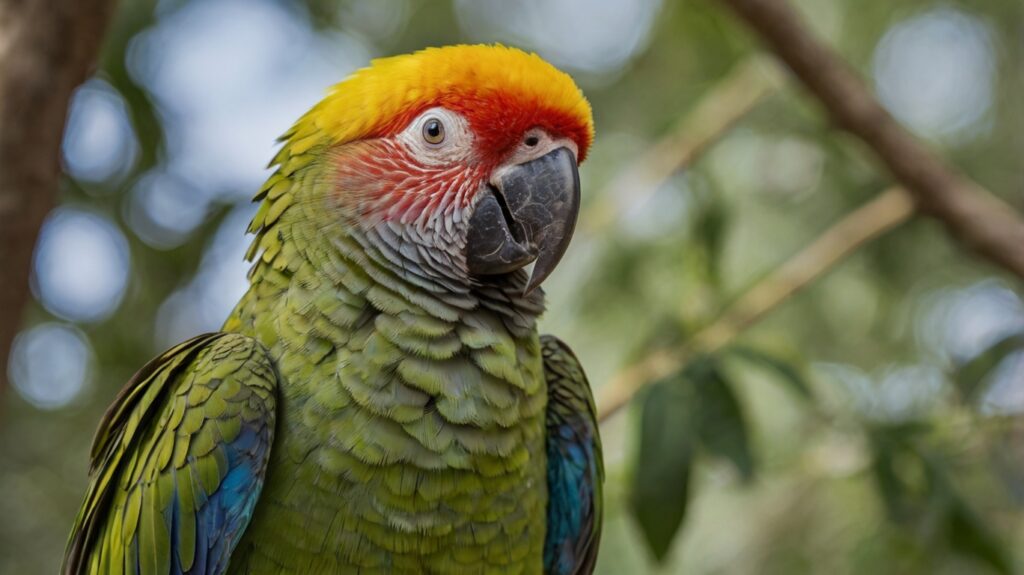Table of Contents
- Introduction
- Physical Characteristics of Pesquet’s Parrot
- Habitat and Distribution
- Diet and Feeding Habits
- Behavior and Social Structure
- Conservation Status and Threats
- Conclusion
- FAQs About Pesquet’s Parrot
Introduction
Pesquet’s Parrot (Psittrichas fulgidus), also known as the Dracula Parrot or Vulturine Parrot, is one of the most distinctive parrot species in the world. Native to New Guinea, this bird stands out due to its unusual vulture-like appearance and specialized feeding habits. Unlike most parrots, Pesquet’s Parrot lacks facial feathers, giving it a striking, almost prehistoric look.
This article explores the physical traits, habitat, diet, behavior, and conservation status of Pesquet’s Parrot, providing a detailed overview of this fascinating species.

Physical Characteristics of Pesquet’s Parrot
Pesquet’s Parrot is easily recognizable due to its unique features:
- Size: Approximately 46 cm (18 inches) in length.
- Coloration: Predominantly black with bright red patches on the belly, wings, and tail.
- Bare Face: Unlike other parrots, it has a featherless face, resembling that of a vulture.
- Strong Beak: Adapted for feeding on figs and other tough fruits.
- Sexual Dimorphism: Males have red ear patches, while females lack them.
This distinct appearance has earned it the nickname “Dracula Parrot.”
Habitat and Distribution
Pesquet’s Parrot is endemic to New Guinea, inhabiting:
- Mountainous rainforests (up to 1,800 meters elevation).
- Lowland forests with abundant fig trees.
- Areas with minimal human disturbance.
Their range is limited, making them vulnerable to habitat destruction.
Diet and Feeding Habits
Unlike most parrots that eat seeds and nuts, Pesquet’s Parrot has a specialized diet:
- Primary Food: Figs (Ficus species).
- Occasional Consumption: Mangoes, nectar, and flowers.
- Feeding Behavior: Uses its strong beak to tear into tough fruit skins.
This dietary specialization makes them dependent on fig-rich forests.
Behavior and Social Structure
- Solitary or Pairs: Often seen alone or in small groups.
- Flight: Strong, direct flight with deep wingbeats.
- Vocalizations: Loud, harsh calls used for communication.
- Nesting: Prefers tree hollows for breeding.
Their behavior is less social compared to other parrot species.
Conservation Status and Threats
Pesquet’s Parrot is classified as Vulnerable (IUCN Red List) due to:
- Habitat Loss: Deforestation for logging and agriculture.
- Hunting: Feathers and meat are sought after in some regions.
- Low Reproduction Rate: Slow breeding increases vulnerability.
Conservation efforts focus on protecting forests and enforcing anti-poaching laws.
Conclusion
Pesquet’s Parrot is a unique and rare bird with striking features and specialized habits. Its survival depends on habitat conservation and reduced hunting pressure. Protecting this species ensures biodiversity in New Guinea’s ecosystems.
FAQs About Pesquet’s Parrot
1. Why is Pesquet’s Parrot called the Dracula Parrot?
Due to its dark plumage, red patches, and featherless face, resembling a vampire-like appearance.
2. Where can Pesquet’s Parrot be found?
Only in New Guinea’s rainforests, both in lowlands and mountains.
3. What does Pesquet’s Parrot eat?
Primarily figs, but occasionally other fruits and nectar.
4. Is Pesquet’s Parrot endangered?
It is Vulnerable, facing threats from habitat loss and hunting.
5. How can we help conserve Pesquet’s Parrot?
Supporting forest conservation programs and anti-poaching initiatives can aid their survival.
